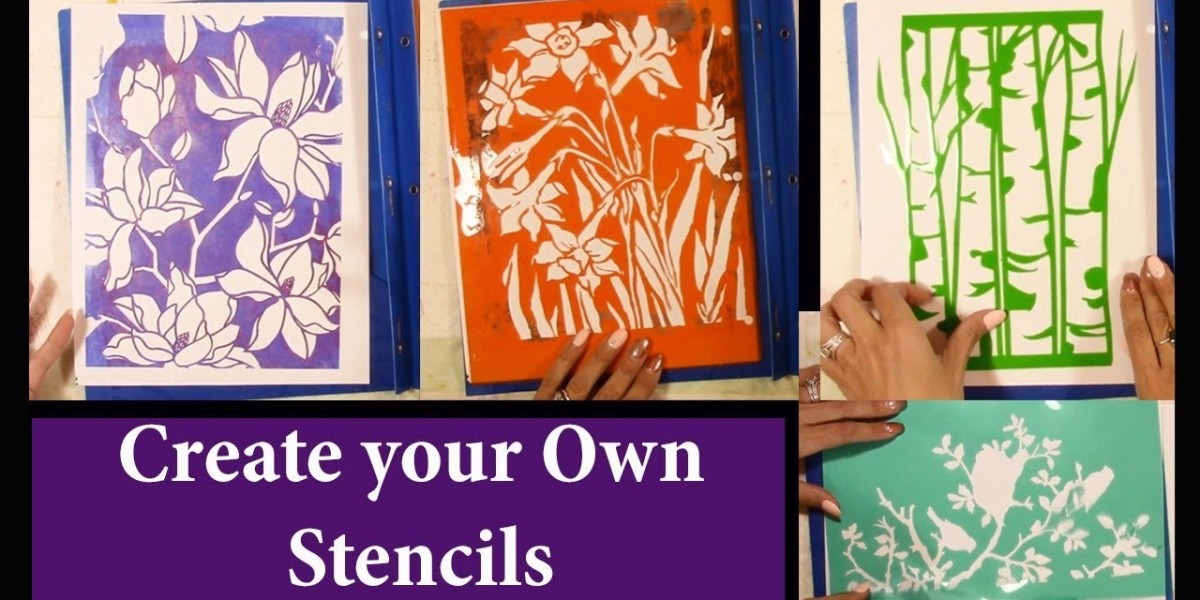Creating custom large stencils can seem like a daunting task, but with the right guidance, it's an enjoyable and rewarding project. This ultimate guide will walk you through the entire process of making your own stencil, from gathering materials to applying your design. Whether you're a seasoned artist or a beginner, this guide will help you create stunning stencils that can be used for various purposes.
Introduction
Have you ever looked at a beautifully stenciled wall or piece of furniture and wondered how you could achieve the same effect? Creating your own custom large stencils is easier than you might think, and this guide will show you how. We'll cover everything you need to know, from the basics of stencil creation to advanced techniques for achieving professional results.
What Are Custom Large Stencils?
Custom large stencils are templates made from various materials that allow you to replicate a design multiple times. They are particularly useful for large-scale projects, such as decorating walls, floors, or furniture. These stencils can be made from paper, plastic, or other materials and can be reused many times.
Benefits of Using Large Stencils
Using large stencils offers several benefits:
Consistency: Stencils ensure that your design is consistent every time you use it.
Time-saving: Once you have your stencil, you can quickly and easily replicate your design.
Cost-effective: Creating your own stencil can be more affordable than purchasing pre-made ones.
Personalization: Custom stencils allow you to create unique designs that reflect your personal style.
Materials Needed
To create your own custom large stencils, you'll need the following materials:
Stencil material: This can be cardstock, plastic sheets, or specialty stencil film.
Cutting tool: A sharp craft knife or a stencil cutting machine.
Design software: Optional, but helpful for creating precise designs.
Adhesive: Spray adhesive or painter's tape to hold your stencil in place.
Paint: Acrylic, spray paint, or other suitable paint for your project.
Brushes or rollers: For applying paint through the stencil.
Choosing the Right Design
Selecting the right design for your stencil is crucial. Consider the following factors:
Complexity: Simple designs are easier to cut and use, while complex designs may require more skill.
Size: Ensure your design fits the space you plan to stencil.
Purpose: Think about the final look you want to achieve and choose a design that complements it.
Preparing Your Workspace
Before you start creating your stencil, prepare your workspace:
Clean surface: Ensure your work surface is clean and free of debris.
Good lighting: Adequate lighting helps you see the details of your design.
Ventilation: If you're using spray adhesive or paint, work in a well-ventilated area.
Creating Your Stencil Design
Creating your stencil design can be done in several ways:
Hand-drawing: If you're artistically inclined, you can draw your design directly onto the stencil material.
Digital design: Use design software to create a precise, scalable design that can be printed and transferred to your stencil material.
Tracing: Find an existing design and trace it onto your stencil material.
Cutting Out Your Stencil
Cutting out your stencil requires patience and precision:
Secure the material: Use tape or adhesive to keep your stencil material in place.
Use a sharp blade: A sharp blade ensures clean, precise cuts.
Take your time: Rushing can lead to mistakes. Take your time and follow the lines of your design carefully.
Applying Your Stencil
Once your stencil is ready, it's time to apply it:
Position the stencil: Use tape or spray adhesive to secure your stencil to the surface.
Apply paint: Use a brush, roller, or spray paint to apply paint through the stencil. Be sure to use a light touch to avoid paint bleeding under the stencil.
Remove the stencil: Carefully lift the stencil away from the surface before the paint dries completely.
Tips and Tricks for Best Results
Here are some tips and tricks to help you achieve the best results with your stencils:
Use a stencil brush: A stencil brush has a flat, circular shape that helps prevent paint from bleeding under the stencil.
Dab, don't brush: Use a dabbing motion to apply paint, rather than brushing, to avoid pushing paint under the stencil.
Layer your paint: Apply multiple light layers of paint for a clean, even finish.
Common Mistakes to Avoid
Avoid these common mistakes when creating and using stencils:
Using too much paint: Excess paint can bleed under the stencil and ruin your design.
Rushing the process: Take your time to ensure clean cuts and precise paint application.
Not securing the stencil: If your stencil moves while you're painting, your design will be distorted.
Creative Ideas for Stencils
Stencils can be used for a variety of creative projects:
Wall art: Create a custom mural or accent wall in your home.
Furniture decoration: Add a unique touch to furniture pieces.
Fabric design: Use stencils to create custom patterns on fabric items like pillows and curtains.
Craft projects: Stencils are perfect for scrapbooking, card making, and other crafts.
Maintaining and Storing Stencils
Proper maintenance and storage will extend the life of your stencils:
Clean after use: Clean your stencil immediately after use to remove any paint residue.
Store flat: Store your stencils flat to prevent them from warping or bending.
Label and organize: Keep your stencils organized and labeled for easy access.
Conclusion
Creating your own custom large stencils is a fun and rewarding project that allows you to express your creativity. By following this guide, you'll be able to create beautiful stencils that can be used for a variety of purposes. Remember to take your time, be patient, and enjoy the process.
FAQs
What materials can I use to make stencils?
You can use cardstock, plastic sheets, or specialty stencil film to create stencils. The material you choose will depend on your project and how often you plan to reuse the stencil.
How do I prevent paint from bleeding under the stencil?
To prevent paint from bleeding, use a stencil brush and apply paint with a dabbing motion. Also, make sure your stencil is securely attached to the surface before you start painting.
Can I use stencils on fabric?
Yes, you can use stencils on fabric. Just make sure to use fabric paint and follow the manufacturer's instructions for setting the paint.
What is the best way to clean stencils?
Clean your stencils immediately after use with warm, soapy water. For stubborn paint, you can use a brush to gently scrub the stencil.
How can I store my stencils to keep them in good condition?
Store your stencils flat in a clean, dry place. Avoid bending or folding them, as this can cause damage. Label and organize your stencils for easy access.








